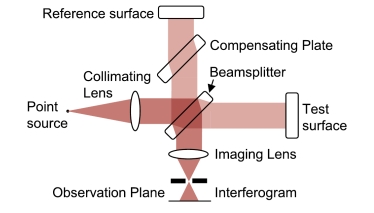Optipedia • SPIE Press books opened for your reference.
Twyman-Green Interferometer
Excerpt from Field Guide to Interferometric Optical Testing
The Twyman-Green interferometer was invented and patented in 1916 and was originally intended for testing prisms and microscope objectives. The invention of the laser increased the utility of the Twyman-Green. Its applicability has grown ever since, and although the laser-based Fizeau is probably the most commonly used testing interferometer, the Twyman-Green is useful for introducing important concepts in interferometers.

The light source for a Twyman-Green is a quasi-monochromatic point source that is collimated by a collimating lens into a plane wave. This plane wave is split into a reference beam and a test beam by a beamsplitter. The basic setup is for the testing of flats, in which case the reference beam reflects off of a known reference flat and returns to the beamsplitter. The test beam is incident on the unknown test part and also returns to the beamsplitter. The beams are both split a second time, creating two complementary interferograms. One is projected towards the point source, while the more useful interferogram is relayed by an imaging lens to the observation plane.

E. P. Goodwin and J. C. Wyant, Field Guide to Interferometric Optical Testing, SPIE Press, Bellingham, WA (2006).
View SPIE terms of use.
Non-Member: $42.00

